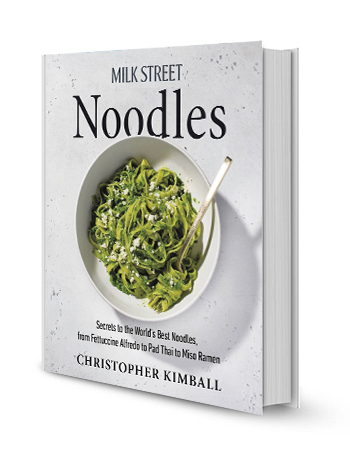Staying Fit


Christopher Kimball, 71, has tested countless recipes since founding the cooking and multimedia company Christopher Kimball’s Milk Street. But he still found surprises while developing his latest cookbook, Milk Street Noodles: Secrets to the World’s Best Noodles, from Fettuccine Alfredo to Pad Thai to Miso Ramen (April 2023). “I think it’s the unexpected that you fall in love with,” he told AARP during a recent interview.


Cook With Christopher
Kimball shared three recipes from Milk Street Noodles for AARP members to try:
Our take on the Italian classic was inspired by a version we tasted at Osteria Broccaindosso in Bologna, Italy.
Miso-Walnut Soba with Bok Choy
Nutty, wholesome Japanese buckwheat noodles and bok choy are sauced with a puree of toasted walnuts and miso that delivers a double hit of umami.
Rigatoni with Pistachio, Ricotta and Herb Pesto
This recipe blends pistachios and ricotta cheese, along with fresh basil and chives, to create a simple pesto to toss with al dente pasta.
The American editor, publisher and chef is best known for founding America’s Test Kitchen in 2001 and the platform’s popular cooking show, Cook’s Country. In 2015, he left America’s Test Kitchen due to a contract dispute and launched Milk Street, a Boston-based company that offers virtual and in-person cooking classes, a TV show, Milk Street magazine, a podcast and a vast library of free recipes. Additionally, Milk Street has published numerous cookbooks, most recently Milk Street Noodles, which seeks to encourage home chefs to look beyond the jar of tomato sauce when whipping up a pasta dish. The book celebrates noodles in all forms and features how they’re used around the globe.
In 2021, Kimball traveled to Los Angeles and learned how to make udon noodles from Sonoko Sakai, a Japanese cooking instructor. “You make the dough and you wrap it in plastic, and you jump up and down and you stomp your feet on it,” he says. “You knead it for 10 minutes.” Then the noodles are cut, cooked and tossed in a sauce. Kimball includes detailed instructions for how to make these noodles in his Udon Noodles with Spicy Meat and Mushroom Sauce recipe.
One way to make lasagna surprised Kimball. “My background — and most people’s backgrounds — is probably you boil some noodles and you put a sauce on it,” he says. “Or you make a casserole, like lasagna.” But at Osteria Broccaindosso in Bologna, Italy, Kimball encountered a lasagna that lacks tomato sauce and mozzarella but instead has besciamella (the Italian version of béchamel, a creamy white sauce of butter, flour and cream) and Parmesan.
“It was many layers, but they’re very thin layers, and it was very soft and very delicate, and it wasn’t this big, heavy, crusty mozzarella dish,” Kimball says. “So I think the surprise for me is that the dishes tend to be lighter.” In the cookbook, Kimball drew inspiration from that recipe for his iteration of Lasagna Bolognese. Barilla oven-ready noodles (the testers preferred these noodles over fresh sheet pasta, Kimball writes) form the base of the lasagna with alternating layers of a hearty meat sauce and besciamella.



































































You Might Also Like
‘Trejo’s Cantina’ Celebrates Los Angeles Mexican Cuisine
Actor Danny Trejo’s second cookbook is an ode to festive gatherings with good friends
Jamie Oliver wants to make life easier with ‘One: Simple One-Pan Wonders’
Chef’s newest cookbook highlights simple and inexpensive meals
Puerto Rican Cookbook Blends History, Diversity
Illyanna Maisonet’s ‘Diasporican’ showcases adaptability of territory’s cooking — on and off the island